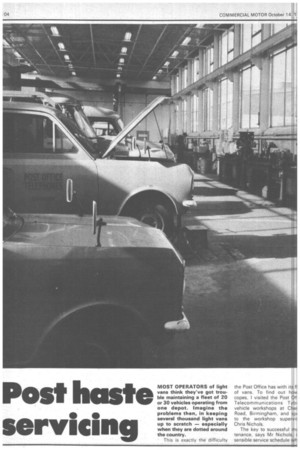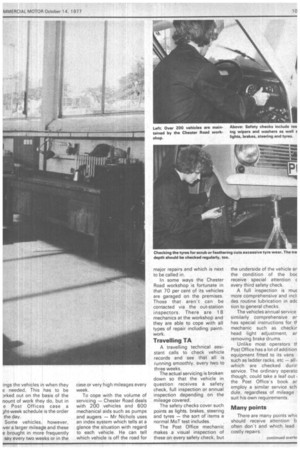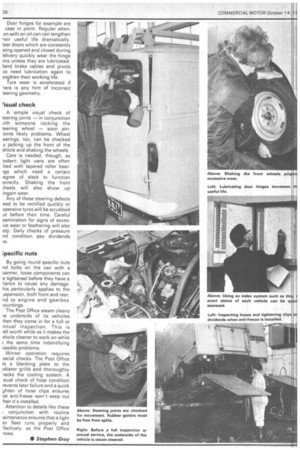Post 1 11 st. MOST OPERATORS of light vans think they've got
Page 106

Page 107

Page 108

If you've noticed an error in this article please click here to report it so we can fix it.
trouble maintaining a fleet of 20 or 30 vehicles operating from one depot. Imagine the problems then, in keeping several thousand light vans up to scratch — especially when they are dotted around the country.
This is exactly the difficulty the Post Office has with its fl of vans. To find out horn copes, I visited the Post Ofi Telecommunications Tybi vehicle workshops at Che Road, Birmingham, and so' to the workshop supervi. Chris Nichols.
The key to successful tenance, says Mr Nichols, i sensible service schedule wh
ings the vehicles in when they e needed. This has to be arked out on the oasis of the nount of work they do, but in e Post Office case a ]ht-week schedul is the order the day.
Some vehicles,, however, iver a larger milea4e and these e brought in more frequently say every two weeks or in the case or very high mileages every week.
To cope with the volume of servicing — Chester Road deals with 200 vehicles and 600 mechanical aids such as pumps and augers — Mr Nichols uses an index system which tells at a glance the situation with regard to each vehicle. He can tell which vehicle is off the road for major repairs and which is next to be called in.
In some ways the Chester Road workshop is fortunate in that 70 per cent of its vehicles are garaged on the premises. Those that aren't can be contacted via the out-station inspectors. There are 18 mechanics at the workshop and they are able to cope with all types of repair including paintwork.
Travelling TA
A travelling technical assistant calls to check vehicle records and see that all is running smoothly, every two to three weeks.
The actual servicing is broken down so that the vehicle in question receives a safety check, full inspection or annual inspection depending on the mileage covered.
The safety checks cover such points as lights, brakes, steering and tyres — the sort of items a normal MoT test includes.
The Post Office mechanic makes a visual inspection of these on every safety check, but the underside of the vehicle ar the condition of the boc receive special attention c every third safety check.
A full inspection is muc more comprehensive and inch des routine lubrication in adc tion to general checks_
The vehicles annual service similarly comprehensive ar has special instructions for tlmechanic such as checkir head light adjustment, ar removing brake drums.
Unlike most operators t1-. Post Office has a lot of addition equipment fitted to its vans such as ladder racks, etc — all which are checked durir service. The ordinary operate though, could take a leaf out the Post Office's book ar employ a similar service sch dule, regardless of mileage suit his own requirements.
Many points
There are many points whic should receive attention b often don't and which lead costly repairs.
Door hinges for example are case in point. Regular attenon with an oil-can can lengthen neir useful life dramatically. tear doors which are constantly leing opened and closed during lelivery quickly wear the hinge 'ins unless they are lubricated. land brake cables and pivots DO need lubrication again to ingthen their working life.
Tyre wear is accelerated if nere is any hint of incorrect teering geometry.
risual check
A simple visual check of Leering joints — in conjunction rith someone rocking the Leering wheel — soon pinoints likely problems. Wheel earings, too, can be checked y jacking up the front of the ehicle and shaking the wheels.
Care is needed, though, as lodern light vans are often tted with tapered roller bearngs which need a certain egree of slack to function orrectly. Shaking the front /heels will also show up ing pin wear.
Any of these steering defects eed to be rectified quickly or xpensive tyres will be scrubbed ut before their time. Careful xamination for signs of exceslye wear or feathering will also elp. Daily checks of pressure nd condition pay dividends
)O.
;pecific nuts
By going round specific nuts nd bolts on the van with a Danner, loose components can e tightened before they have a hance to cause any damage his particularly applies to the Jspension, both front and rear, nd to engine and gearbox iountings.
The Post Office steam cleans le underside of its vehicles then they come in for a full or nnual inspection. This is worth while as it makes the 9hicle cleaner to work on while t the same time indentifying ossible problems.
Winter operation requires )ecial checks. The Post Office ts a blanking plate to the idiator grille and thoroughly necks the cooling system. A sival check of hose condition revents later failure and a quick Oten of hose clips ensures tat anti-freeze won't seep out 'hen its installed.
Attention to details like these I conjunction with routine iaintenance ensures that a light in fleet runs properly and 'fectively, as the Post Office lows.
• Stephen Gray












































































































































































